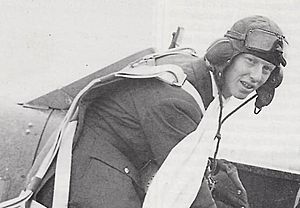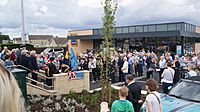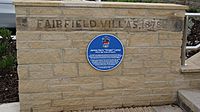James Harry Lacey facts for kids
Quick facts for kids
James Harry Lacey
|
|
|---|---|

"Ginger" Lacey c. 1940.
|
|
| Nickname(s) | "Ginger" |
| Born | 1 February 1917 Wetherby, West Riding of Yorkshire, England |
| Died | 30 May 1989 (aged 72) Bridlington, East Riding of Yorkshire, England |
| Allegiance | United Kingdom |
| Service/ |
Royal Air Force |
| Years of service | 1937–1967 |
| Rank | Squadron Leader |
| Unit | No. 501 Squadron RAF (1939–41) No. 57 Operational Training Unit (1941) No. 602 Squadron RAF (1942) No. 81 Group (1942) No. 1 Special Attack Instructors School (1942) No. 20 Squadron RAF (1943) 1572 Gunnery Flight (1943) |
| Commands held | No. 17 Squadron RAF (1944–46) No. 155 Squadron RAF (1944) |
| Battles/wars | Second World War
|
| Awards | Distinguished Flying Medal & Bar Mentioned in Despatches Croix de guerre (France) |
| Other work | Owner of a cargo air carrier, flight instructor |
James Harry Lacey, DFM & Bar (born February 1, 1917 – died May 30, 1989), was a very brave pilot for the Royal Air Force during World War II. He was one of the top fighter pilots. He was also the second-highest scoring pilot during the famous Battle of Britain. Lacey was known for shooting down 28 enemy aircraft. He also likely shot down five more and damaged nine others.
Contents
Growing Up
James Lacey finished King James Grammar School in 1933. He then studied at Leeds Technical College. For four years, he worked as an apprentice pharmacist.
Joining the Air Force
In January 1937, Lacey joined the Royal Air Force Volunteer Reserve (RAFVR). He trained as a pilot in Perth, Scotland. In 1938, he became an instructor at the Yorkshire Flying School. He flew for 1,000 hours before the war began. When the war started, he joined No. 501 Squadron RAF.
World War II Adventures
Fighting in France
On May 10, 1940, Lacey's squadron moved to Bétheniville in France. There, he had his first combat experience. On May 13, over Sedan, he destroyed a Heinkel He 111 bomber and a Messerschmitt Bf 109 fighter. Later that day, he shot down a Messerschmitt Bf 110.
He claimed two more He 111s on May 27. His squadron then returned to England on June 19. They had claimed almost 60 victories in France. On June 9, his plane was damaged, and he crash-landed. He almost drowned in a swamp. For his bravery in France, he received the French Croix de Guerre medal.
Battle of Britain Hero
Lacey flew throughout the Battle of Britain with No. 501 Squadron. They were based at RAF Gravesend or RAF Croydon. He became one of the highest-scoring pilots during this important battle. His first victory in the battle was on July 20, 1940. He shot down a Bf 109E fighter.
On August 12, he claimed a destroyed Ju 87 and a "probable" Ju 87. He damaged a Bf 110 and a Do 17 on August 15. On August 16, he had a probable Bf 109. He destroyed a Ju 88 and damaged a Dornier Do 17 on August 24. On August 29, he shot down a Bf 109. He had to bail out safely on August 13 after his plane was hit.
On August 23, 1940, Lacey received the Distinguished Flying Medal. This was for destroying six enemy aircraft.
On August 30, 1940, during a fight over the Thames Estuary, Lacey shot down a He 111. He also damaged a Bf 110. His Hurricane plane was badly hit by enemy fire. His engine stopped, but he decided to glide back to Gravesend airfield. He chose this instead of bailing out into the Estuary.
He finished a very successful August by destroying a Bf 109 on August 31.
On September 2, 1940, Lacey shot down two Bf 109s and damaged a Do 17. He then shot down two more Bf 109s on September 5. During a big raid on September 13, he attacked He 111 bombers over London. He shot down one bomber that had just bombed Buckingham Palace. He then had to bail out of his plane because of bad visibility. He got minor injuries.
He quickly returned to action. On September 15, 1940, he shot down an He 111 and three Bf 109s. He also damaged another. This day was one of the heaviest fighting days of the battle. It became known as "Battle of Britain Day". During the battle, he attacked 12 Bf 109s. He shot down two before the others even noticed him. Then he escaped into the clouds.
Two days later, on September 17, he was shot down over Ashford, Kent. This happened during a dogfight with Bf 109s. He bailed out without injury. On September 27, he destroyed a Bf 109. He damaged a Junkers Ju 88 on September 30. In October, he claimed a probable Bf 109 on October 7. He shot down a Bf 109 on October 12, another on October 26, and on October 30, he destroyed a Bf 109 before damaging another.
During the Battle of France and the Battle of Britain, Lacey was shot down or forced to land nine times.
On November 26, 1940, Lacey had 23 claims. Eighteen of these were made during the Battle of Britain. He received a Bar to his Distinguished Flying Medal. This was for his amazing courage during the Battle of Britain.
After 1940
Lacey received another award, a Mention in Despatches, on January 1, 1941. He became a pilot officer on January 25, 1941. He was promoted to acting flight lieutenant in June. On July 10, 1941, he shot down a Bf 109. He damaged another a few days later. On July 17, he claimed a Heinkel He 59 seaplane. On July 24, he caused two Bf 109s to collide, shooting them down.
In August 1941, he stopped combat operations. He became a flight instructor. He was promoted to flying officer on September 22.
In March 1942, Lacey joined No. 602 Squadron. They flew the Spitfire Mk V. By March 24, he had damaged a Fw 190. He damaged another Fw 190 on April 25, 1942. Then he became a tactics officer. He was promoted to flight lieutenant on August 27. In November, he became Chief Instructor at a special attack instructors school.
In March 1943, Lacey went to India. He joined No. 20 Squadron. In July, he joined 1572 Gunnery Flight. He learned to fly Republic P-47 Thunderbolts. He stayed in India. In November 1944, he commanded No. 155 Squadron, flying Spitfire VIII planes. Later that month, he commanded No. 17 Squadron. While in India, Lacey claimed his last aircraft on February 19, 1945. He shot down a Japanese Army Air Force Nakajima Ki 43 "Oscar" with only nine cannon rounds.
Lacey was one of the few RAF pilots who flew missions on both the first and last days of the war. His final count was 28 confirmed enemy aircraft destroyed. He also had four probables and nine damaged.
After the War
After the war, Lacey went to Japan with No. 17 Squadron. He was the first Spitfire pilot to fly over Japan on April 30, 1946. He returned to the UK in May 1946. He retired from the RAF on March 5, 1967. He held the rank of squadron leader.
Later Life and His Legacy
After retiring, Lacey ran an air cargo business. He also taught at a flight school near Bridlington. He helped director Guy Hamilton with his 1969 film Battle of Britain. Hamilton said Lacey was "totally invaluable" as an adviser.
Lacey passed away on May 30, 1989, at age 72. In September 2001, a plaque was put up at Priory Church in Bridlington, Yorkshire, to remember him. There is also a plaque where Lacey grew up in Wetherby.
An image of Lacey is displayed on one of the Knaresborough Town Windows. These are special trompe-l'œil images managed by Renaissance Knaresborough.
In 2016, Beverley/Linley Hill Airfield named their new flight training center after Lacey. On July 23, 2017, a blue plaque was put on the site of his childhood home.




